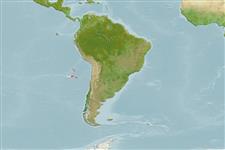>
Anguilliformes (Eels and morays) >
Ophichthidae (Snake eels) > Myrophinae
Etymology: Scolecenchelys: Greek, skolex = worm (1855) + Greek, enchlys, -yos = eel (Ref. 45335); profundorum: From the Latin profundorum, meaning 'of the depths' (Ref. 13468).
More on authors: McCosker & Parin.
Environment: milieu / climate zone / depth range / distribution range
Écologie
marin bathydémersal; profondeur ? - 310 m (Ref. 13468). Deep-water
Southeast Pacific: Endemic to Nazca Ridge.
Taille / Poids / Âge
Maturity: Lm ? range ? - ? cm
Max length : 33.4 cm TL mâle / non sexé; (Ref. 13468)
Description synthétique
Clés d'identification | Morphologie | Morphométrie
Vertèbres: 162. This species of the Scolecenchelys gymnota species group is distinguished by the following set of characters: head 8.7 % TL; tail 52 % TL; uniserial teeth on jaws and vomer; horizontal distance between dorsal-fin origin and a vertical through mid-anus 51 % HL; predorsal vertebrae 75, preanal 68, total 162 (Ref. 104540).
Minimum depth from Ref. 58018.
Life cycle and mating behavior
Maturité | Reproduction | Frai | Œufs | Fécondité | Larves
Hibino, Y. and S. Kimura, 2015. Revision of the Scolecenchelys gymnota species group with descriptions of two new species (Anguilliformes: Ophichthidae: Myrophinae). Ichthyol Res (Ref. 104540)
Statut dans la liste rouge de l'IUCN (Ref. 130435: Version 2024-2)
Menace pour l'homme
Harmless
Utilisations par l'homme
Outils
Articles particuliers
Télécharger en XML
Sources Internet
Estimates based on models
Phylogenetic diversity index (Ref.
82804): PD
50 = 0.5000 [Uniqueness, from 0.5 = low to 2.0 = high].
Bayesian length-weight: a=0.00076 (0.00029 - 0.00197), b=3.06 (2.83 - 3.29), in cm total length, based on LWR estimates for this (Sub)family-body shape (Ref.
93245).
Niveau trophique (Ref.
69278): 4.0 ±0.7 se; based on size and trophs of closest relatives
Résilience (Ref.
120179): Faible, temps minimum de doublement de population : 4,5 à 14 années (Assuming tmax>10).
Fishing Vulnerability (Ref.
59153): Low vulnerability (23 of 100).
